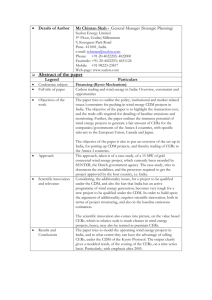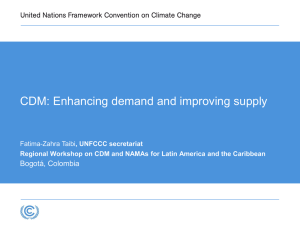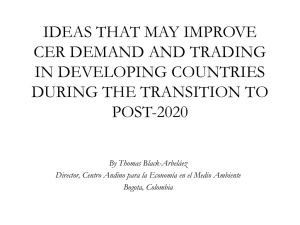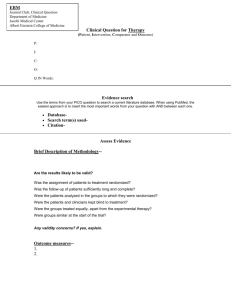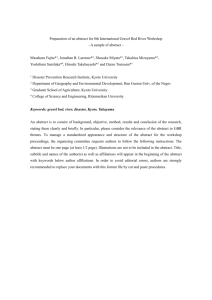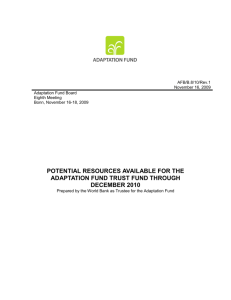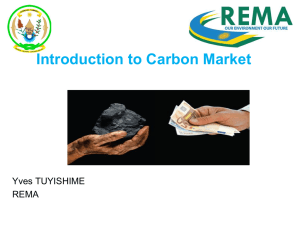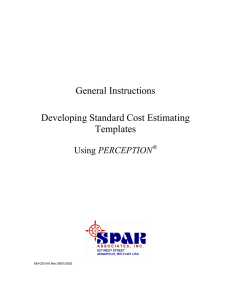Climate Change, UNFCCC and Kyoto Protocol
advertisement
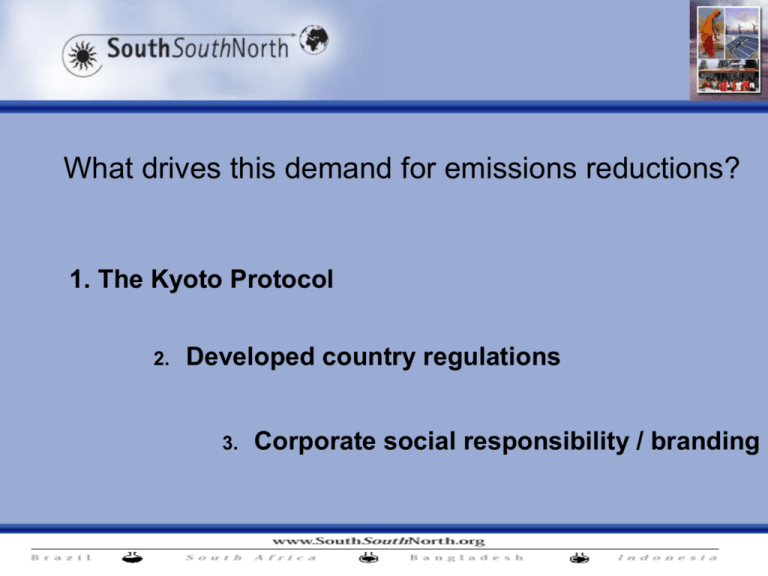
What drives this demand for emissions reductions? 1. The Kyoto Protocol 2. Developed country regulations 3. Corporate social responsibility / branding The Kyoto Protocol • The developed countries have set an average target of 5% below their ghg emission levels in 1990. • These targets are to be achieved by 2008-2012, the “first commitment period”. • They can use 3 “Flexible Mechanisms” to help them: - Emissions Trading, - Clean Development Mechanism (CDM) - Joint Implementation (JI) • Developing countries don’t have targets for the “first commitment period”. Emissions Trading • Based on the principle of cost efficiency: by establishing a market for emission reductions, you get the most number of reductions at the lowest cost. • Greenhouse gases mix uniformly in the atmosphere - so it does not matter where you reduce them • Targets are set, and you can either achieve that target by making emission reductions yourself, or you can buy from an emitter that has improved on its target. • This creates an incentive to maximize reductions, but emissions trading is controversial! Supply and Demand in the Carbon Market – where are the buyers? Demand for carbon credits Supply of carbon credits C C C C C C CDM regions Corporate Social Responsibility Including: • Involvement in trading schemes • Carbon offset programmes • Project development within multinationals • Renewable energy and energy efficiency initiatives CER’s • A CER is like a share certificate • CER’s will be registered in an international bourse and each one will be individually numbered and described. • They are anticipated to be fully fungible and so any owner can hold them and speculate with them, or • Use them to prove compliance with a country target, in which case they “retire”. CDM portfolio 10 million credits over ten years 1m 1m 1m 1m 1m 1m 1m 1m 1m 1m .06m .06m 600 000 credits over ten years .06m .06m .06m .06m .06m .06m .06m .06m 5 million over ten years .5m .5m .5m .5m .5m .5m .5m .5m .5m .5m 1 1.06 1.06 1.06 1.56 1.56 1.56 TOTAL CREDITS 8 9 12 8 10 12 16 Price 8 etc 2006 2007 TOTAL REVENUE 2008 2009 2010 2011 2012 2013 2014 2015 2016 2017 2018 201 9 2020 Step 4: Timing of CER transactions First Kyoto Commitment Period First Phase EU ETS Feb 2004 2005 2008 2012 Second Commitment Period? Bilateral/Unilater al • • • What the hell is this? Alt 1: equity investment for CER swap “bilateral” Alt 2: “unilateral” 1. Sell forward 2. Sell on spot 3. Bank Step 3: Unilateral vs Bilateral Transaction Models Unilateral Bilateral/Multilateral No Annex 1 Project Participant One or more project participants from an Annex 1 country CERs sold over-the-counter or through forward contracts CERs contracted as returns to financial/ technical investment Low risk to purchaser for CERs Medium risk to investor as they sold post issuance contract forward, but have influence over project success High risk to purchaser for forward sales Unclear whether this model is eligible under the EB rules Model initially envisaged by Kyoto Many projects under development Very few projects under development Purchasers of CERs Investors v Buyers • Investors: – Contribute • Capital • Technology – Receive • Equity • Profit share • Joint venture • Buyers: – Purchase CERs • Off the shelf • Forward Purchase Steps to reduce Project Participant risk during the transaction process Necessary Desirable First Prize! • Project Idea Note • Project participant identified • PDD Complete • Financial feasibility with all shareholders identified • Technological feasibility undertaken • OE identified • Validation Complete • DNA approval complete • Other financial shareholders committed Step 4: Types of Risk and Mitigation Strategies - Project Failure Construction & operation risk assessment:; written contracts - Underperformance Conservative CER contracts; insurance - Project Feasibility Audited financial and technical feasibility assessments - Policy (Kyoto) Transfer risk to buyer through contract; sell into VER market - Country Prepare country risk report, follow unilateral model - Exchange Rate Identify the effects of an appreciation/depreciation; est. financing strategy - DNA Get letter confirming legislative/policy consistency if no - Ownership DNA/rules Clearly establish and document ownership - Validation Use accredited DOE; get pre-validation assessment; use approved methodology - Market Uncertainties Undertake market appraisal; monitor the market; est. a forward price curve Steps in the Transaction Process 1. Identify potential buyers 2. Approach potential buyers requesting expressions of interest in the CERs 3. Assess Expressions of Interest (EOIs) and identify the buyer with whom you wish to negotiate and which transaction model you with to transact under 4. Negotiate and structure contract, either an Emission Reduction Purchase 5. Agreement (ERPA) or Direct Purchase Agreement (DPA) 6. Finalise contract and transact Throughout process… identify and take steps to mitigate risks! Overview of the Carbon Market • Fragmented but emerging • Currently: diverse set of buyers interested in trading carbon units (EU ETS, Japanese companies) • Carbon credits are ‘created’ through Emissions Trading Schemes or Projects, and registered in a registry • Market growth (64m tonnes Jan-May 04, already equal to 2003) • Where SA fits (CCC in PointCarbon ratings) Carbon Market transactions.. At this stage of market development, It’s likely that carbon purchasers will purchase forward in some way: • • • • option right of first refusal forward purchase on some formula outright purchase Purchase contracts could therefore span over 10 years. These are governed by ERPAs Steps One and Two: Who is buying and brokering CERs? Annex One governments: • The Dutch, EU governments, Canadians Institutional/Fund Buyers: • World Bank • CDC IXIX (French Fund) Private Companies: • Sumitomo, Nippon, Holcim, Anglo, Nuon Offset Purchasers: • 500ppm Brokers • Natsource, Evolution Markets, CO2e Step 4: CER Contract Considerations • The project’s overall viability (CER delivery risk) • Credit standing of the project sponsor • Kyoto and EB risk • Validation and certification costs • Type of trade, payment terms • Credit vintage • Additional environmental and social benefits • Project type (scheme eligibility risk) • Country and exchange rate risks Step 4: Example of constructing a forward price curve Carbon Market: Forward Price Curve Price in Euros 16 14 EUAs 12 Anticipated Kyoto ET credit 10 CERs, seller takes Kyoto risk 8 6 CERs, buyer takes Kyoto risk 4 Canadian ETS price cap 2 0 2002 2004 2006 2008 Year 2010 2012 2014 Step 5: Transaction • Using ERPA (Emission Reduction Purchase Agreement) for forward sales • Using DPA (Direct Purchase Agreement) for over-the-counter sales Incorporating options, forward sales, right of first refusal See IETA website www.ieta.org for an example…. Who is buying and brokering CERs? Annex One governments: • The Dutch, Danish, Austrians Institutional/Fund Buyers: • World Bank PCF • CDC IXIX (French Fund) Private Companies: • Sumitomo, Nippon, Holcim, Anglo, Nuon Offset Purchasers: • 500ppm, Climate Care, Future Forests Brokers • Natsource, Evolution Markets, CO2e Session Overview 1) Introducing SSN 2) Introducing the case study: Bellville Landfill project 3) An overview of the Carbon Market 4) The risk and reward trade-off 5) Transactions group exercise 6) Feedback and discussion CER Payment.. At this stage of market development, It’s likely that CER purchasers will in most cases purchase forward in some way… • • • • This can either by option Or right of first refusal Or forward purchase on some formula Or outright purchase Who is buying and brokering CERs? Annex One governments: • The Dutch, EU governments, Canadians Institutional/Fund Buyers: • World Bank • CDC IXIX (French Fund) Private Companies: • Sumitomo, Nippon, Holcim, Anglo, Nuon Offset Purchasers: • 500ppm Brokers • Natsource, Evolution Markets, CO2e Steps in the Transaction Process 1. Identify potential buyers 2. Approach potential buyers requesting expressions of interest in the CERs 3. Assess EOIs and identify the buyer with whom you wish to negotiate and which transaction model you with to transact under 4. Negotiate and structure contract in an Emission Reduction Purchase Agreement (ERPA) 5. Finalise contract and transact Risk is crucial! • At various points of the project cycle, there exist levels of risk to both the participants and the potential buyer • Risk is shared in projects that involve an investor • Risks are different for the developer and prospective CER buyer Risks to CDM Projects The risks to CDM projects can be classified into two types: 1) General Project Risks 2) CDM Specific Risks As a general rule, the more advanced the project, the lower the risks General Project Risks • • • • • • • Exchange Rate Financial Demand for product Country Construction, Operation & Maintenance Legislative Project Location CDM Specific Risks Again, two types: those that are internal and those that are external to the project External - Kyoto Ratification - EU ETS Demand - Full fungibility of CERs - Clarity on 2nd Commitment Period - EB registration stringency - Timing of external market demand CDM Specific Risks (cont.) Internal - Methodology approval - DNA Approval - Validation - Gold Standard Certification
